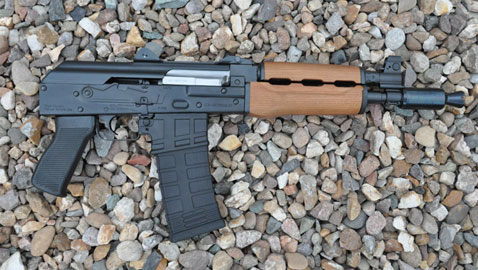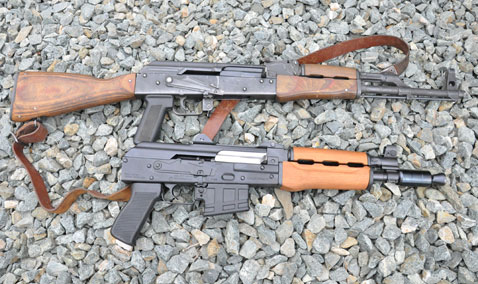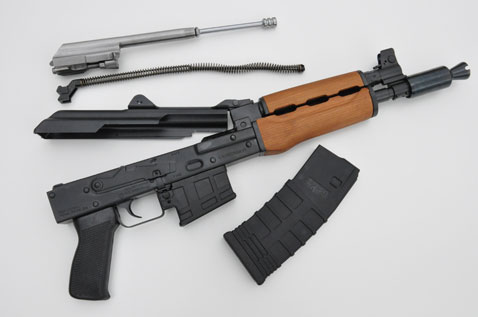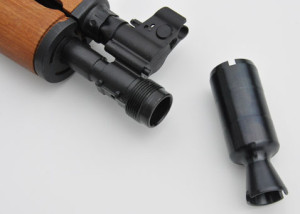Widgetized Section
Go to Admin » Appearance » Widgets » and move Gabfire Widget: Social into that MastheadOverlay zone
PAP M85 NP .223 Pistol

The Model PAP M85 NP is a semi-automatic pistol with a 10.25 inch barrel.
Boris and I met during his first class at Gunsite. A Russian Jew, he had served in the Red Army infantry before leaving Russia for Israel, then later, the United States. His real name wasn’t Boris but it was a nickname that stuck. One day we were talking about the AK- 47 and I asked him about cleaning the rifle. Boris replied, with a horrified look on his face, “Vhy vould you?”
The Avtomat Kalashnikova, Mikhail Kalashnikov’s assault rifle, remains the most prolific of military small arms. More than 70 million have been manufactured and the rifle and its many variations have been built in Russia, Albania, Bulgaria, China, Egypt, Poland, Romania and Yugoslavia, among other places. Wait a minute. Did I say Yugoslavia? Yes, Yugoslavia is gone but the Zastava firearms plant in Serbia remains in operation producing high quality civilian and military weapons. These days, AK-47/AKM – type rifles made there are often referred to as Yugo AKs and are considered some of the best made anywhere. The subject of this review is a new AK pistol variation because it’s chambered, not in the usual 7.62 X 39 caliber, but in .223 Remington/5.56 NATO and unlike other AKs it is made with a magazine well extension allowing the use of standard M-16/AR-15 magazines. This model should be popular with American shooters so when I heard J&G Sales of Prescott, Arizona was getting in a shipment of these pistols I had to buy one and try it out. Adding to the appeal of this pistol is the price. At $499 it is about half what you might expect to pay for an AR pistol.

The Model PAP M85 NP is a semi-automatic pistol with a 10.25 inch barrel. It’s reminiscent of the short barreled, fully automatic Krinkov AKs and sports the distinctive Krinkov style flash hider. Overall length of the pistol, including the flash hider, is 21 5/8 inches. The unloaded weight is 6 pounds, 7 ounces and the weight with the fully loaded 30 round Tapco polymer magazine provided is 7 pounds, 9 ounces. The sights are what you would expect on a Yugo AK rifle. Attached to the hinged top cover, the rear sight has two flip-up blades with white dots marked 2 and 4 for 200 and 400 meters. The front sight is an elevation adjustable AK sight that includes a flip up white dot post that’s a little easier to see than the plain, black one. The pistol grip is checkered plastic, the bolt and carrier are plain steel and the operating rod and piston are chromed. The forend is smooth wood with three ventilation holes, a feature distinctive to the Serbian models. The stamped metal receiver, hammer forged barrel and other metal parts have a black, slightly shiny finish. The safety lever, located on the right side of the receiver, is two-position; up for safe and down for fire, but with a twist. AK pattern rifles normally have no provision for locking the bolt to the rear but the safety on the M85 has a notch on the top that can be used to lock the bolt to the rear by capturing the bolt handle. What a simple solution to the way AKs have operated since, oh, 1947. The trigger on my M85 is pretty good for a two stage military trigger. After about ½” of gritty take-up the trigger breaks crisply at about 5 pounds. There is no over-travel (movement of the trigger after sear release) and the trigger resets with a positive click.

At the range my objective was to see how well the M85 functioned with a variety of .223 ammunition fed from different magazines. I used Federal 55 grain (gr.) soft points, Federal and Black Hills 55 gr. full metal jacket, and Hornady 65 gr. hollow points fed from the magazine that comes with the pistol as well as 20 and 30 round magazines from Magpul, 30 round mags from Colt and Brownells and a few other magazines of various origins. A note on reloading: The M85 has a push button magazine release on the right side of the magazine well extension, rather than the AK style paddle release located in front of the trigger guard. The magazines fit snugly and don’t drop free when  the magazine release button is depressed. If you’re expecting to execute a competition style speed reload with this pistol you’re going to be disappointed. On the other hand, it may not be an issue if you’re comfortable with 30 rounds in a magazine. I reload by grabbing the magazine and pressing the release button with the same hand, using a finger on the left hand or the thumb on the right. I pull the magazine out, drop it or put it away, insert a fresh magazine, grasp the charging handle and run the bolt. Because the bolt of AK guns doesn’t lock to the rear when empty, I’m in the habit of pulling the bolt handle to the rear and releasing it when I change magazines on any AK system gun – to make sure there’s a round in the chamber. For me, shooting right handed, it’s easier to keep my right hand on the pistol grip and reload with the left. I roll the pistol to the right and run the bolt handle from underneath. Pulling on the bolt handle with the left hand while pushing forward with the right makes the operation more positive.
the magazine release button is depressed. If you’re expecting to execute a competition style speed reload with this pistol you’re going to be disappointed. On the other hand, it may not be an issue if you’re comfortable with 30 rounds in a magazine. I reload by grabbing the magazine and pressing the release button with the same hand, using a finger on the left hand or the thumb on the right. I pull the magazine out, drop it or put it away, insert a fresh magazine, grasp the charging handle and run the bolt. Because the bolt of AK guns doesn’t lock to the rear when empty, I’m in the habit of pulling the bolt handle to the rear and releasing it when I change magazines on any AK system gun – to make sure there’s a round in the chamber. For me, shooting right handed, it’s easier to keep my right hand on the pistol grip and reload with the left. I roll the pistol to the right and run the bolt handle from underneath. Pulling on the bolt handle with the left hand while pushing forward with the right makes the operation more positive.
With Boris in mind I didn’t clean the M85 before or during testing. Using what I imagined might be Russian infantryman methods, I lubricated the bolt with motor oil from the dipstick of my truck. The pistol ran with everything I fed it from every one of the magazines I used and there were no malfunctions. AKs are known for being reliable but I was worried that one feeding .223 ammunition from AR magazines might not function properly. As it turns out, my concerns were unfounded. Speaking of malfunctions, when Boris and I were talking about AKs I asked him whether Red Army soldiers were trained to repair AKs. He said, “Vhy bother? Throw it avay and get another vun.”
Stay tuned. I’m working up a Part II with more information on shooting the M85 NP, accuracy testing and accessories to set it up as a proper truck gun or home defense weapon.
For more information, visit www.jgsales.com
About the Author:
 Ed Head is a regular on Shooting Gallery, Gun Stories and Down Range TV. He has worked for almost 30 years in law enforcement, first in the United States Air Force and then with the United States Border Patrol, retiring as a Field Operations Supervisor. During his Border Patrol career, Ed worked in a variety of patrol, investigative and training capacities. Ed has an extensive background as a firearms instructor, having trained thousands, ranging from beginners to police, military and special operations personnel. Having taught at Gunsite for 20 years, Ed first trained there under the world famous shooting school’s founder, Jeff Cooper, then later ran the school as the operations manager for more than five years. Ed lives in Chino Valley, Arizona, where he continues to teach and write.
Ed Head is a regular on Shooting Gallery, Gun Stories and Down Range TV. He has worked for almost 30 years in law enforcement, first in the United States Air Force and then with the United States Border Patrol, retiring as a Field Operations Supervisor. During his Border Patrol career, Ed worked in a variety of patrol, investigative and training capacities. Ed has an extensive background as a firearms instructor, having trained thousands, ranging from beginners to police, military and special operations personnel. Having taught at Gunsite for 20 years, Ed first trained there under the world famous shooting school’s founder, Jeff Cooper, then later ran the school as the operations manager for more than five years. Ed lives in Chino Valley, Arizona, where he continues to teach and write.



 MidwayUSA
MidwayUSA Ruger Firearms
Ruger Firearms SCCY Firearms
SCCY Firearms Streamlight
Streamlight Action Targets
Action Targets Gunsite Academy
Gunsite Academy
You must be logged in to post a comment Login